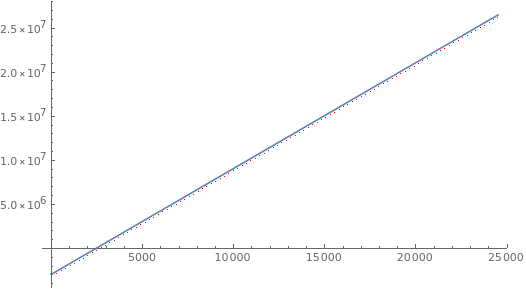I have a function that is shown in the image, below.
The point I am interested in extracting (numeric fine) is, in this case, 200. This appears to be the point at which one derivative is infinite.
It is also possible this is the inflection point?
What would be the best way(s) to tackle this in MMA?
Update 1:
The point on the surface of this function I wish to obtain is {0.2,200}.It appears from the shape of the function it is easiest to first find the y point which always seems to have the 'features' shown in the plot.
Update 2:
The following constraints always hold: a>0 and b>0
Plot3D[f[a,b], {a, 0, 400}, {b, 0, 0.5}]
f[a_, b_] =
1/b 30.` (-7.681373803360649` +
0.011809163818525368` a (-((
20.60129077457011` E^(-((
0.03333333333333333` (-4.605170185988092` +
15.` (0.05` - b^2/2) + Log[a])^2)/b^2)))/(a b)) + (
0.2060129077457011` E^(
7.5` b^2 + 15.` (0.05` - b^2/2) - (
0.03333333333333333` (-4.605170185988092` + 15.` b^2 +
15.` (0.05` - b^2/2) + Log[a])^2)/b^2))/b +
E^(7.5` b^2 +
15.` (0.05` - b^2/2)) (1 +
Erf[(0.18257418583505533` (-4.605170185988092` + 15.` b^2 +
15.` (0.05` - b^2/2) + Log[a]))/b])) -
0.0033333333333333335` (-3.54274914555761` (-100.` (1 +
Erf[(0.18257418583505533` (-4.605170185988092` +
15.` (0.05` - b^2/2) + Log[a]))/b]) +
a E^(7.5` b^2 +
15.` (0.05` - b^2/2)) (1 +
Erf[(0.18257418583505533` (-4.605170185988092` +
15.` b^2 + 15.` (0.05` - b^2/2) + Log[a]))/b])) +
0.23618327637050734` (-((
309.01936161855167` E^(-((
0.03333333333333333` (-4.605170185988092` +
15.` (0.05` - b^2/2) + Log[a])^2)/b^2)))/b) + (
3.090193616185517` a E^(
7.5` b^2 + 15.` (0.05` - b^2/2) - (
0.03333333333333333` (-4.605170185988092` + 15.` b^2 +
15.` (0.05` - b^2/2) + Log[a])^2)/b^2))/b +
15.` a E^(
7.5` b^2 +
15.` (0.05` - b^2/2)) (1 +
Erf[(0.18257418583505533` (-4.605170185988092` +
15.` b^2 + 15.` (0.05` - b^2/2) + Log[a]))/b]))) +
0.11809163818525367` a^2 b^2 ((
20.60129077457011` E^(-((
0.03333333333333333` (-4.605170185988092` +
15.` (0.05` - b^2/2) + Log[a])^2)/b^2)))/(a^2 b) + (
0.2060129077457011` E^(
7.5` b^2 + 15.` (0.05` - b^2/2) - (
0.03333333333333333` (-4.605170185988092` + 15.` b^2 +
15.` (0.05` - b^2/2) + Log[a])^2)/b^2))/(a b) + (
1.3734193849713405` E^(-((
0.03333333333333333` (-4.605170185988092` +
15.` (0.05` - b^2/2) + Log[a])^2)/
b^2)) (-4.605170185988092` + 15.` (0.05` - b^2/2) +
Log[a]))/(a^2 b^3) - (1/(a b^3))
0.013734193849713406` E^(
7.5` b^2 + 15.` (0.05` - b^2/2) - (
0.03333333333333333` (-4.605170185988092` + 15.` b^2 +
15.` (0.05` - b^2/2) + Log[a])^2)/
b^2) (-4.605170185988092` + 15.` b^2 + 15.` (0.05` - b^2/2) +
Log[a])))



b -> 0? $\endgroup$